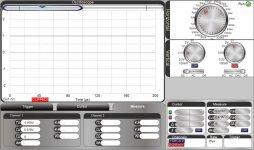First as always let me say thank you. I had to go to work today but have got some readings in. Second let me say that I am a computer scientist by training but a consultant by trade. So i am gifted in sounding a lot more knowledgeable than i really am so forgive me for the silly questions. I am serviceable with the Oscope and am learning everyday. I dont have a professional grade scope either. With that said i started at the beginning of the HORZ drive as suggested. Using the settings Dave provided (thanks) and worked out from pin 7 to R33. And that waveform looks correct and the Ohms where 1K ohms through R33. I then moved to R37 just before Q12 and got a flat high waveform nothing like the pictures.
Picture #8 (.5V - 20 us) Output of R33 (CR15) - Input to Q11

Picture #9 (.5v - 20us) Output of R37 - Input to Q12

There seems to be an issue here in comparison with what the schematic shows on #9. I measured Ohms and i get -1 on the meter so i assume that means something is wrong (consultant remember). Not trying to be all smart now but does this sound like a possible issue that we see further down. Should i follow the rest of the chain?
Picture #8 (.5V - 20 us) Output of R33 (CR15) - Input to Q11

Picture #9 (.5v - 20us) Output of R37 - Input to Q12

There seems to be an issue here in comparison with what the schematic shows on #9. I measured Ohms and i get -1 on the meter so i assume that means something is wrong (consultant remember). Not trying to be all smart now but does this sound like a possible issue that we see further down. Should i follow the rest of the chain?

